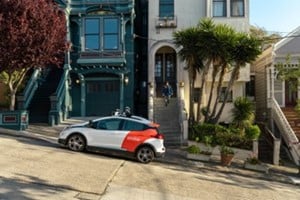An autonomous vehicle (AV) is a technology where there is a partial driver (or no driver) navigating the vehicle from the start to the destination.
The first feature that paved the way towards cars becoming AVs is cruise control, where cars can be set to maintain a certain speed but the driver is required to control everything else. Then technology improved to adaptive cruise control, where in addition to maintaining a set speed, cars can detect if the car in front of them slows down and match their pace in response.
Additionally, lane-keeping technology was developed, a feature that senses the road lines and aids the driver in staying between them. In the 1980s, universities began researching and developing this technology using a variety of sensors that try to identify the road and any objects in the vehicle’s path.
By using autonomous vehicles, we can decrease road congestion, improve crash avoidance, and reduce travel costs. Two of the current front-runners in the AV business are Tesla and Waymo. Waymo has been testing its autonomous systems over 20 million miles of public roads, while Tesla’s cars have gone 3 billion miles on autopilot. Click here to learn more about the future of autonomous vehicles.
The Future of Autonomous Vehicles

Growing up, we were promised a future of flying cars and self-driving vehicles. Cartoons and movies were riddled with images and ideas of what the future of transportation would hold.
Many companies, including startups and automotive giants, are pouring resources into autonomous vehicles. If you spend a day exploring San Francisco, Calif.,, you will find self-driving vehicles calibrating their software among the crowded streets and hilly terrain.
As engineers, we are aware of the risks of technology but also the endless possibilities. In March 2023, a Cruise autonomous vehicle caused a collision with a San Francisco Municipal Transit Authority bus due to a software error. The Cruise vehicle rear-ended the bus which caused moderate damage to the Cruise vehicle but did not result in any injuries. Cruise responded swiftly and took the collision seriously, and the incident prompted the company to recall autonomous driving software in about 300 vehicles.
The news often highlights the flaws and errors in technology, but we forget to consider the flaws of human drivers. Ninety-four percent of all car accidents are due to human error, and autonomous driving features can help lower this number drastically. Many autonomous driving features such as automatic emergency braking, blind spot warnings, and lane departure warnings are already implemented in vehicles and have prevented accidents.
SAE International has published a guide for the six levels of driving automation. If you are curious about where your vehicle may fall on the scale, you can find details on the different levels here.
Our society is getting closer to the childhood dreams of self-driving vehicles and all the possibilities that come with them.
Author
-

SWE Blog provides up-to-date information and news about the Society and how our members are making a difference every day. You’ll find stories about SWE members, engineering, technology, and other STEM-related topics.






